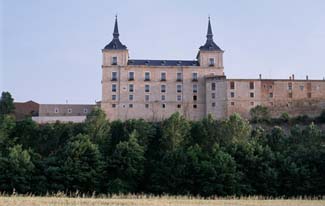
Photos courtesy of Parador de Lerma
Plaza Mayor, 1
09340 Lerma
(Burgos)
Tel: ++34 947 17 71 10
Fax: ++34 947 17 06 85
Official parador website
Reserve with Booking.com
70 rooms
Double rooms: 90–190 euros
Single rooms: 80% of double
room rate
Rates include tax. Breakfast extra.
Free Wi-Fi
Open: all year
Lerma is 36 km south of Burgos off route A-1. The parador is on the Plaza Mayor.
Nearby: golf; walks around Lerma; excursions to Burgos and Covarrubias
Opened in 2003, the Parador de Lerma showcases the would-be extravagance of one of Spain’s more colorful personalities: the duke of Lerma.
Situated on the highest point in the center of town, the austere and massive appearance palace belies the warmth and comfort inside.
The most striking feature of the palace is the great interior patio surrounded by 40 columns of Tuscan and Ionic style, with an enormous skylight above.
Guest rooms look down on the patio. They are handsomely decorated with the occasional hand-carved piece of furniture and terra-cotta floor with throw rugs. All have large modern bathrooms. Some rooms have views.
Arched ceilings look down on the restaurant, located in the oldest part of the palace. You’ll find on the menu typical Castilian cuisine such as suckling lamb roasted in a wood-fired oven, stews, and blood sausage with rice. Fresh river fish are lighter options.
![]() Each of the four towers holds a guest room with a canopied bed and a 360º view.
Each of the four towers holds a guest room with a canopied bed and a 360º view.